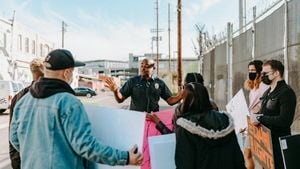California stands on the brink of new legislation aimed at curbing students' smartphone use, as Governor Gavin Newsom recently reached out to school districts with his latest initiative.
On August 13, 2024, Newsom's office announced plans encouraging tighter limitations on cellphone access during school hours, addressing growing concerns over distractions and mental health issues stemming from social media.
Besides California, South Carolina is also tackling this issue, with its education board expected to approve guidelines aimed at restricting phone use within schools.
These developments signal a larger initiative across several states, including Utah and Florida, to implement measures against cellphone distractions in classrooms.
Though many schools have enacted cellphone bans, enforcement can be inconsistent, leading to ineffective policies and continued distractions.
Newsom's recent correspondence urges districts to take immediate action, underscoring the importance of providing focused educational environments for students.
He warned about the potential dangers smartphones pose to student well-being, echoing concerns raised by the U.S. Surgeon General Vivek Murthy, who has advocated for warning labels on social media platforms.
Newsom remarked, "Every classroom should be a place of focus, learning, and growth," emphasizing the need for collaboration among educators, parents, and students.
The governor's recommendation, stemming from legislation passed back in 2019, does not impose strict rules but rather encourages districts to set their own regulations.
This conversation about restricting cellphone use is not new; many educators argue for more creative solutions beyond blanket bans.
Antero Garcia, a professor at Stanford University's Graduate School of Education, expressed frustration over the repetitive nature of this debate, stating, "What I’m struck by is society’s inability to kind of move forward and find other kinds of solutions."
He also highlighted the practical challenges teachers face when the school year begins, as limiting smartphone access can become more complicated once students settle back in.
Among the districts actively enforcing cellphone restrictions are the Santa Barbara Unified and Los Angeles Unified school districts.
Despite this movement, some educational leaders, like Troy Flint from the California School Boards Association, argue against imposing universal bans, advocating for localized decision-making based on community needs.
Flint pointed out, "Cellphone usage and social media usage on campus is certainly a serious issue and one ... specific to certain schools and certain communities."
While there may not be one-size-fits-all solutions, the renewed discussion aims to inspire schools to create more effective strategies around cellphone use among students.
California Teachers Association president David Goldberg stressed the importance of engaging parents, educators, and students alike, stating, "It makes sense for us as adults to be ... safe spaces to learn."
With these conversations gaining momentum, it's clear the issue of cellphone restrictions is pushing schools toward exploring various approaches to balance education with digital connectivity.



